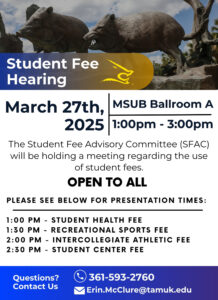High school students roam the campus at Texas A&M University – Kingsville (TAMUK).
TAMUK partners with 20 school districts who send some of their students to college while still taking courses in high school, which is called dual enrollment. This list includes Premont, Freer, San Diego and Brooks County ISDs.
In total, these high schools send 1,159 students to TAMUK.
The schools pay for tuition, books and supplies for their students, allowing at-risk kids the opportunity to get a college education. By the time they graduate high school they can have up to 60 college credits.
Miranda Joiner, coordinator of the dual enrollment program, believes the program is a great benefit to these students.
“Through their participation, high school students gain first-hand knowledge as to the college-level academic and social expectations that facilitate the transition of motivated students to higher education,” Joiner said.
Superintendent of Premont ISD, Steve VanMatre, applauds the program.
“From an academic perspective, the level of rigor in the classroom, the standards of a typical four-year university within the Texas A&M University system is hard to duplicate at a comprehensive 2A high school,” VanMatre said. “It’s priceless for our kids.”
At Premont ISD, 120 out of the 152 students take college courses, 71 of them take the classes through TAMUK and eight percent are special needs.
Since Premont ISD enrolled students in the dual enrollment program the percent of their students who went to college rose from seven to 70 percent
Animal Science and Pre-Vet major Jodi Linscomb is enrolled through the dual enrollment program at Freer ISD.
“I enjoy it because I get to experience new things other kids don’t, I have more opportunities, like when I graduate I’m going to have maybe 30 hours,” Linscomb said. “It’s difficult at the same time because I’m in sports and it’s a lot sometimes, but I have a good support system.”
However, Linscomb points out the flawed execution of preparing them for college.
“I feel like the teachers go easier on us. It’s not like we’re in an actual college class. I don’t think we’re really that prepared for college, like we’re going to get a rude awakening,” Linscomb said.
Sociology Lecturer Kristina Bernal-Marichalar sees the same issue from a different perspective.
“In theory the dual enrollment program is wonderful, the practice of it might need a little bit of tweaking,” Marichalar said.
In the 2018 summer session, Marichalar taught a course with 40 students. The course had a high school-to-college senior ratio of approximately four to one. In her student evaluations for that class a few students felt the course was too easy.
“After the first three or four assignments I recognized that these students still needed a little more work as far as understanding the theories,” Marichalar said.
Not only does Marichalar make assignments a little easier she alters the material to easier as well.
“As I go over my lecture notes right before class I take certain things out because I don’t know if the dual enrollment student is going to understand, or misinterpret, what I’m meaning, especially when I talk about sexuality, crime rates, abortion and drug usage,” Marichalar said. “When I do throw out figures and research-based materials I don’t know if they are going to understand that’s what the research supports versus are they going to think that it’s my opinion.”
Another potential problem for putting high school students in a university environment is the possibility of a relationship with an older student.
“I do worry that they’re going to develop a social relationship with an older student and go somewhere they shouldn’t,” VanMatre said. “That’s why prior to every semester we do as much education as we can with the family to make them aware that there are risks and this is what we’re going to do to minimize those risks.”
While instructors want their students to have experience going to college on their own, they want to ensure an inappropriate relationship does not happen.
Early College High School Administrator for Premont ISD Nina Everett faces this issue.
“We keep as close an eye on them as we can, but we do actually want them to get the experience of being around college students maybe creating friendships with them, study groups and interacting with them in an academic way,” Everett said.
